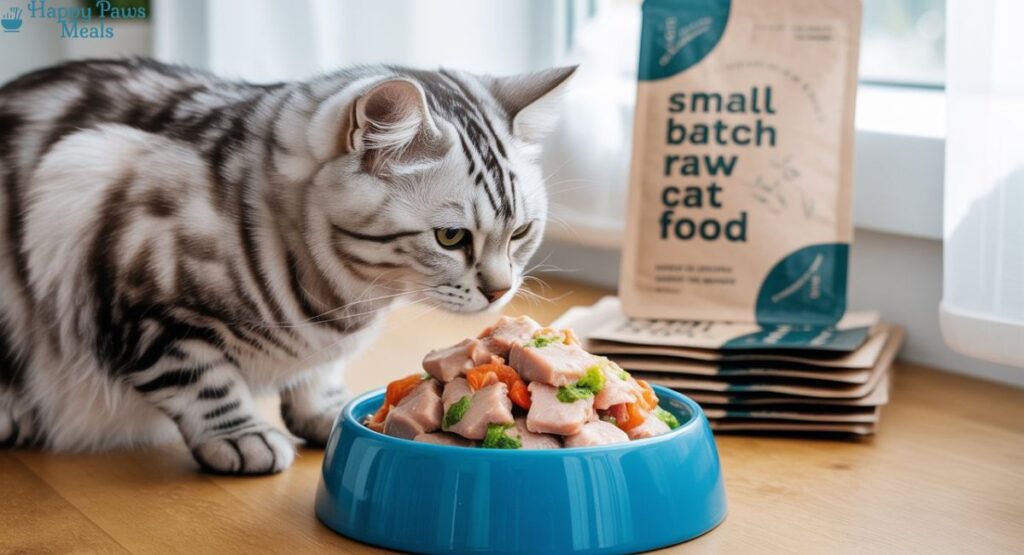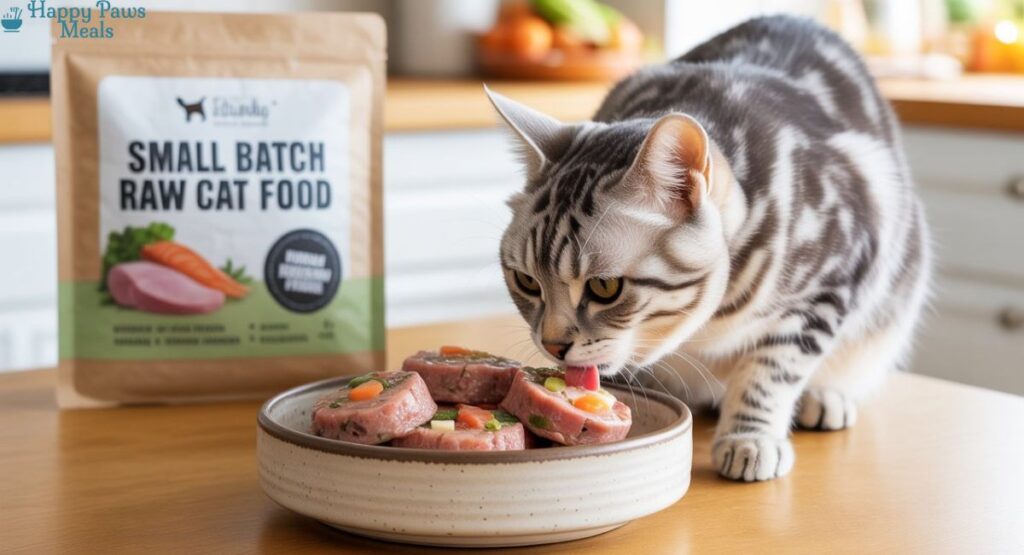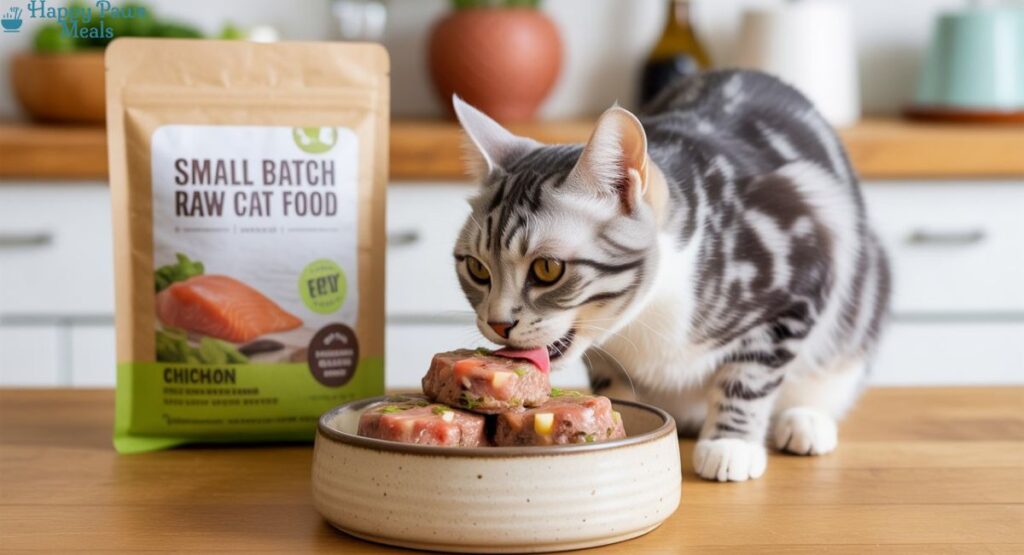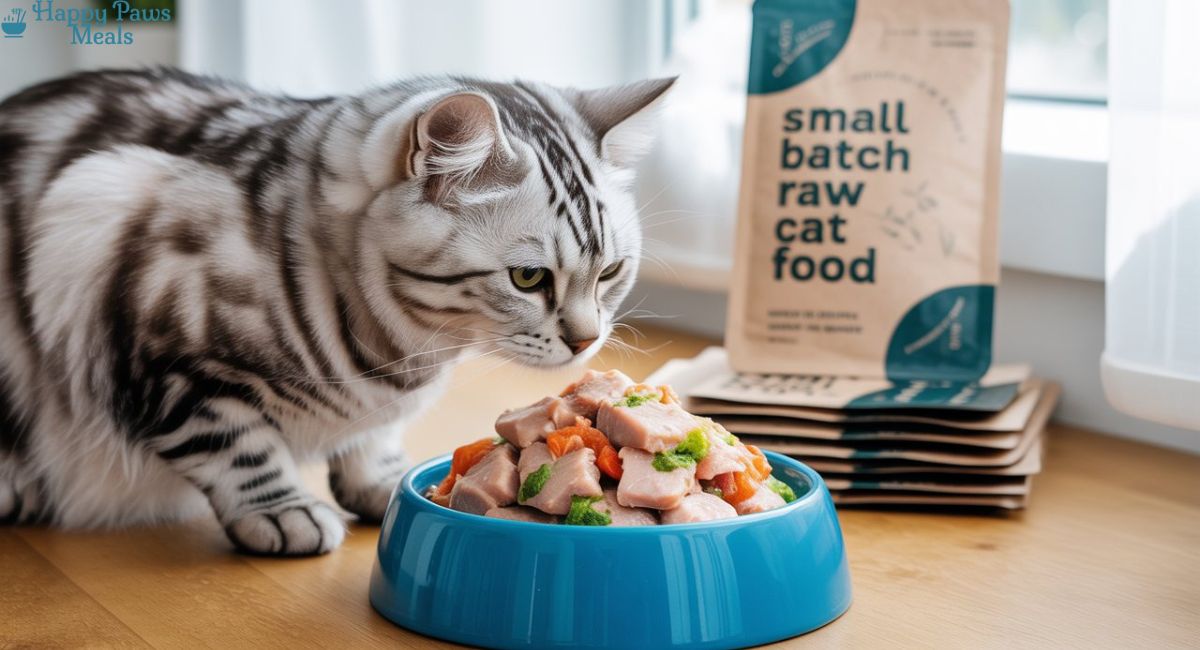Pet parents today are more informed than ever, and many are no longer satisfied with traditional kibble or canned food. They want better nutrition, transparency in sourcing, and diets that support the natural needs of their cats. One trend that has gained massive attention in recent years is small batch raw cat food.
This diet focuses on quality over quantity, using locally sourced meats, organs, and bones to create biologically appropriate meals for cats. Unlike mass-produced kibble that relies heavily on fillers and preservatives, small batch raw food is minimally processed, nutrient-rich, and designed to mimic a cat’s ancestral diet.
But what exactly is small batch raw cat food? Why are so many cat parents making the switch? And is it safe for your feline? This complete guide will cover everything—from how it’s made to its nutritional profile, health benefits, risks, top brands in 2026, and feeding tips. According to the FDA’s guidelines on raw pet food safety, proper handling and storage of raw diets is essential to prevent contamination
By the end, you’ll know whether small batch raw cat food is the right choice for your furry friend.
What is Small Batch Raw Cat Food?
Small batch raw cat food is raw, minimally processed food made in limited quantities by smaller, often independent pet food companies. These recipes are crafted with careful attention to ingredient sourcing, nutrition, and safety.

Most reputable raw brands ensure their formulas meet the AAFCO nutrient requirements for cats Unlike large-scale commercial pet food manufacturers, small batch producers emphasize:
- High-quality proteins → Grass-fed beef, free-range chicken, wild-caught fish, rabbit, duck, or lamb.
- Organs and bones → Vital for vitamins, minerals, and calcium-phosphorus balance.
- Minimal additives → Few or no fillers, artificial preservatives, or synthetic chemicals.
- Transparency → Many brands disclose sourcing, farming practices, and nutrition testing.
Think of it like the farm-to-table movement for cats—wholesome, fresh, and crafted with care.
Small Batch vs. Mass-Produced Pet Food
| Feature | Small Batch Raw Cat Food | Mass-Produced Kibble/Canned Food |
|---|---|---|
| Ingredients | Whole meats, organs, bones, fresh produce | By-products, fillers, preservatives |
| Processing | Minimal (frozen raw) | High heat, extrusion, synthetic vitamins |
| Nutrition | Protein-rich, low carb | Higher carbs, lower protein |
| Batch Size | Limited, craft-style | Industrial-scale |
| Transparency | High (often local sourcing) | Limited sourcing info |
For cat parents seeking premium, biologically appropriate diets, small batch raw food is often the top choice.
How Small Batch Raw Cat Food is Made
The production of small batch raw cat food focuses on freshness, nutrition, and safety. While processes vary, most brands follow these steps:
1. Ingredient Sourcing
- Meat & Organs: Chicken, turkey, beef, lamb, rabbit, duck, or fish.
- Bones: Ground for calcium and phosphorus.
- Supplements: Taurine, omega-3 fatty acids, probiotics, and vitamins.
- Produce (optional): Pumpkin, spinach, or blueberries for fiber and antioxidants.
Many small batch brands highlight human-grade meats, antibiotic-free poultry, and organic produce.
2. Preparation & Grinding
Meats, organs, and bones are ground and portioned into balanced ratios (muscle meat ~70–80%, organs ~10–15%, bone ~10%).
3. Freezing & Storage
Instead of cooking, the food is frozen immediately. This preserves nutrients, maintains freshness, and prevents spoilage without artificial preservatives.
4. Packaging
Food is shaped into patties, nuggets, or chubs (rolls of ground meat) for easy portioning.
5. Safety Testing
Brands test for pathogens like Salmonella or E. coli and ensure balanced nutrition.
👉 Compared to kibble manufacturing, this method is gentler and closer to nature, keeping nutrients intact.
Nutritional Profile of Small Batch Raw Cat Food
Cats are obligate carnivores, meaning they require a meat-based diet. Small batch raw food is designed to mimic their natural prey intake. Veterinarians often recommend checking resources like the American Veterinary Medical Association (AVMA) before switching your cat to a raw diet.
Typical Nutritional Breakdown
- Protein: 50–65% → Supports muscle health and energy.
- Fat: 25–30% → Provides essential fatty acids for skin, coat, and brain.
- Moisture: 60–70% → Prevents dehydration and supports kidney health.
- Carbohydrates: <5% → Much lower than kibble, reducing obesity risks.
- Taurine → Essential for heart health, vision, and reproduction.
- Micronutrients → Naturally present in bones and organs.
Small Batch vs. Kibble vs. Canned
| Nutrient | Small Batch Raw | Dry Kibble | Canned Food |
|---|---|---|---|
| Protein | 50–65% | 25–35% | 35–45% |
| Fat | 25–30% | 10–20% | 15–25% |
| Moisture | 60–70% | 8–10% | 70–80% |
| Carbs | <5% | 30–50% | 10–20% |
Clearly, small batch raw diets are closer to a cat’s natural biological needs than kibble.

Benefits of Small Batch Raw Cat Food
Pet parents who switch to small batch raw often report noticeable improvements in their cats’ health and behavior.
✅ Better Digestion
Raw diets are easier to digest since they avoid fillers like corn, soy, or wheat. Cats often have firmer, smaller stools and fewer stomach upsets.
✅ Improved Hydration
High moisture content supports kidney health and reduces the risk of urinary tract infections.
✅ Shinier Coat & Healthier Skin
The natural omega fatty acids in raw meat promote soft, shiny coats and reduce dandruff or itching.
✅ Weight Management
Low-carb, high-protein diets support lean muscle while preventing obesity.
✅ Stronger Teeth & Bones
Chewing meaty bones (in some recipes) helps reduce plaque buildup and strengthens teeth.
✅ Boosted Energy & Vitality
Cats often appear more playful, energetic, and alert when fed a protein-rich raw diet.
✅ Natural Eating Behavior
The texture, smell, and taste of raw food appeal to cats’ instincts, making mealtime more satisfying.
Risks & Concerns
While small batch raw cat food offers many benefits, it’s important to understand the risks.
❌ Bacterial Contamination
Raw meat can contain Salmonella, E. coli, or Listeria. Cats handle these better than humans, but contamination is still possible.
❌ Nutritional Imbalances
DIY or poorly balanced raw diets may lack taurine, calcium, or other essentials. Trusted brands balance formulas to AAFCO standards.
❌ Storage & Handling
Raw food requires freezer storage and careful thawing. Mishandling can increase contamination risk.
❌ Higher Cost
Small batch raw food is more expensive than kibble, making it less affordable for some owners.
👉 Bottom line: safe handling, reputable brands, and proper storage reduce these risks. If you’re exploring different diets, you may also like our guide on Frozen Raw Cat Food: A Complete Guide for Cat Parents in 2026
Popular Small Batch Raw Cat Food Brands (2026)
Here are some trusted names leading the small batch raw movement:
1. Smallbatch Pets
- Family-owned, based in the USA.
- Uses organic produce, grass-fed meats, and free-range poultry.
- Offers frozen raw sliders, patties, and blends.
2. Primal Pet Foods
- Known for ethically sourced ingredients.
- Offers frozen nuggets and patties for cats.
- Adds organic vegetables and supplements for balance.
3. Stella & Chewy’s
- One of the most popular raw brands.
- Offers frozen raw and freeze-dried options.
- Wide protein variety: chicken, turkey, rabbit, duck, and more.

For dry food lovers, we’ve reviewed the Best Dry Cat Food for Cats in 2026
4. Instinct Raw (Nature’s Variety)
- Large-scale raw brand with small batch-inspired quality.
- AAFCO-approved balanced formulas.
- Frozen raw bites and medallions for cats.
5. Raw Paws Pet Food
- Specializes in customizable raw feeding.
- Offers single-protein meats and full raw diets.
- Great for cat parents who want flexibility.
Buying Guide: How to Choose Small Batch Raw Cat Food
When shopping, look for:
- Whole Ingredients → Real meat, organs, and bones.
- AAFCO Compliance → Ensures balanced nutrition.
- Protein Variety → Rotate proteins to prevent sensitivities.
- Brand Reputation → Choose transparent, trusted companies.
- Your Cat’s Needs → Consider age, weight, and health issues.
How to Transition Your Cat to Small Batch Raw
Cats are creatures of habit. A slow transition ensures success.
- Start with 10–15% raw mixed into current food.
- Gradually increase raw over 7–14 days.
- Monitor stool consistency and appetite.
- Adjust based on your cat’s comfort.
Storage & Handling Tips
- Store frozen until ready to use.
- Thaw in the refrigerator, never at room temperature.
- Serve within 30 minutes.
- Wash hands, bowls, and surfaces after handling.
DIY Small Batch Raw Cat Food (Optional)
Some cat parents prepare homemade small batch raw meals. A typical recipe includes:
- 80% muscle meat (chicken, turkey, rabbit, or beef).
- 10% organ meat (liver, kidney, or heart).
- 10% raw bone (ground or powdered).
- Supplements: taurine, vitamin E, fish oil.
⚠️ Always consult a vet or nutritionist before DIY raw feeding.
FAQs About Small Batch Raw Cat Food
1. Is small batch raw cat food safe?
Yes, when sourced from reputable brands and handled properly.
2. Can kittens eat small batch raw diets?
Yes, but they need formulas designed for growth.
3. Do vets recommend raw diets?
Opinions vary—some support raw, while others prefer cooked diets.
4. How expensive is it?
It’s more costly than kibble but seen as an investment in long-term health.
5. How long does it last in the freezer?
6–12 months when properly stored.
Final Thoughts
Small batch raw cat food offers a natural, nutrient-rich alternative to heavily processed kibble and canned diets. By focusing on high-quality ingredients, minimal processing, and biologically appropriate nutrition, it provides cats with food that’s closer to what they’d eat in the wild.
Yes, it requires more effort, freezer space, and cost—but for many cat parents, the results are worth it: shinier coats, better digestion, healthier weight, and happier, more energetic cats.
If you’re considering the switch, choose a trusted brand, transition gradually, and always follow safe food-handling practices. Done right, small batch raw cat food can transform your cat’s health—one bowl at a time.

I’m Awais Manzoor, the writer behind HappyPawsMeals. With years of interest in pet care and nutrition, I research and review cat and dog food to provide reliable, easy-to-understand advice for pet parents.

